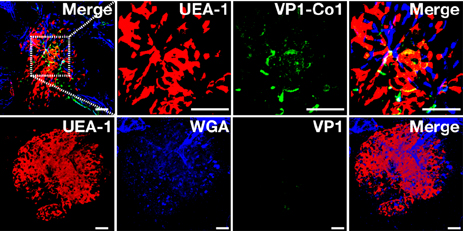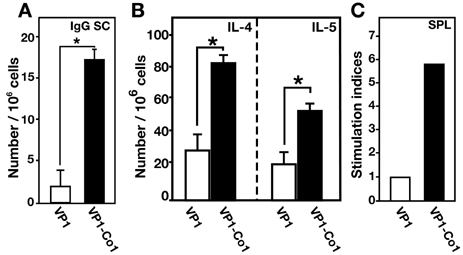Immune Netw.
2013 Aug;13(4):157-162. 10.4110/in.2013.13.4.157.
Targeted Delivery of VP1 Antigen of Foot-and-mouth Disease Virus to M Cells Enhances the Antigen-specific Systemic and Mucosal Immune Response
- Affiliations
-
- 1Department of Molecular Biology, Interdisciplinary Program of Bioactive Materials, and Institute for Molecular Biology and Genetics, Chonbuk National University, Jeonju 561-756, Korea. yongsuk@jbnu.ac.kr
- KMID: 2150781
- DOI: http://doi.org/10.4110/in.2013.13.4.157
Abstract
- Application of vaccine materials through oral mucosal route confers great economical advantage in animal farming industry due to much less vaccination cost compared with that of injection-based vaccination. In particular, oral administration of recombinant protein antigen against foot-and-mouth disease virus (FMDV) is an ideal strategy because it is safe from FMDV transmission during vaccine production and can induce antigen-specific immune response in mucosal compartments, where FMDV infection has been initiated, which is hardly achievable through parenteral immunization. Given that effective delivery of vaccine materials into immune inductive sites is prerequisite for effective oral mucosal vaccination, M cell-targeting strategy is crucial in successful vaccination since M cells are main gateway for luminal antigen influx into mucosal lymphoid tissue. Here, we applied previously identified M cell-targeting ligand Co1 to VP1 of FMDV in order to test the possible oral mucosal vaccination against FMDV infection. M cell-targeting ligand Co1-conjugated VP1 interacted efficiently with M cells of Peyer's patch. In addition, oral administration of ligand-conjugated VP1 enhanced the induction of VP1-specific IgG and IgA responses in systemic and mucosal compartments, respectively, in comparison with those from oral administration of VP1 alone. In addition, the enhanced VP1-specific immune response was found to be due to antigen-specific Th2-type cytokine production. Collectively, it is suggested that the M cell-targeting strategy could be applied to develop efficient oral mucosal vaccine against FMDV infection.
MeSH Terms
Figure
Reference
-
1. O'Donnell V, LaRocco M, Duque H, Baxt B. Analysis of foot-and-mouth disease virus internalization events in cultured cells. J Virol. 2005; 79:8506–8518.2. Rodriguez LL, Grubman MJ. Foot and mouth disease virus vaccines. Vaccine. 2009; 27:Suppl 4. D90–D94.
Article3. Zhang LJ, Chen HT, Zhou JH, Ma LN, Ding YZ, Liu YS. Research in advance for FMD novel vaccines. Virol J. 2011; 8:268.
Article4. Cubillos C, de la Torre BG, Jakab A, Clementi G, Borrás E, Bárcena J, Andreu D, Sobrino F, Blanco E. Enhanced mucosal immunoglobulin A response and solid protection against foot-and-mouth disease virus challenge induced by a novel dendrimeric peptide. J Virol. 2008; 82:7223–7230.
Article5. Mestecky J, Nguyen H, Czerkinsky C, Kiyono H. Oral immunization: an update. Curr Opin Gastroenterol. 2008; 24:713–719.
Article6. Pasetti MF, Simon JK, Sztein MB, Levine MM. Immunology of gut mucosal vaccines. Immunol Rev. 2011; 239:125–148.
Article7. Brandtzaeg P. Mucosal immunity: induction, dissemination, and effector functions. Scand J Immunol. 2009; 70:505–515.
Article8. Holmgren J, Czerkinsky C. Mucosal immunity and vaccines. Nat Med. 2005; 11:4 Suppl. S45–S53.
Article9. Kim SH, Seo KW, Kim J, Lee KY, Jang YS. The M cell-targeting ligand promotes antigen delivery and induces antigen-specific immune responses in mucosal vaccination. J Immunol. 2010; 185:5787–5795.
Article10. Kim SH, Jung DI, Yang IY, Kim J, Lee KY, Nochi T, Kiyono H, Jang YS. M cells expressing the complement C5a receptor are efficient targets for mucosal vaccine delivery. Eur J Immunol. 2011; 41:3219–3229.
Article11. Hase K, Kawano K, Nochi T, Pontes GS, Fukuda S, Ebisawa M, Kadokura K, Tobe T, Fujimura Y, Kawano S, Yabashi A, Waguri S, Nakato G, Kimura S, Murakami T, Iimura M, Hamura K, Fukuoka S, Lowe AW, Itoh K, Kiyono H, Ohno H. Uptake through glycoprotein 2 of FimH(+) bacteria by M cells initiates mucosal immune response. Nature. 2009; 462:226–230.
Article12. Cerutti A, Chen K, Chorny A. Immunoglobulin responses at the mucosal interface. Annu Rev Immunol. 2011; 29:273–293.
Article13. Azizi A, Kumar A, Diaz-Mitoma F, Mestecky J. Enhancing oral vaccine potency by targeting intestinal M cells. PLoS Pathog. 2010; 6:e1001147.
Article14. Kim SH, Lee KY, Jang YS. Mucosal Immune System and M Cell-targeting Strategies for Oral Mucosal Vaccination. Immune Netw. 2012; 12:165–175.
Article15. Hutber AM, Kitching RP, Fishwick JC, Bires J. Foot-and-mouth disease: the question of implementing vaccinal control during an epidemic. Vet J. 2011; 188:18–23.
Article16. Cerutti A. The regulation of IgA class switching. Nat Rev Immunol. 2008; 8:421–434.
Article17. Strugnell RA, Wijburg OL. The role of secretory antibodies in infection immunity. Nat Rev Microbiol. 2010; 8:656–667.
Article18. Kaetzel CS, Robinson JK, Chintalacharuvu KR, Vaerman JP, Lamm ME. The polymeric immunoglobulin receptor (secretory component) mediates transport of immune complexes across epithelial cells: a local defense function for IgA. Proc Natl Acad Sci USA. 1991; 88:8796–8800.
Article19. Pabst O. New concepts in the generation and functions of IgA. Nat Rev Immunol. 2012; 12:821–832.
Article20. Schulz O, Pabst O. Antigen sampling in the small intestine. Trends Immunol. 2013; 34:155–161.
Article
- Full Text Links
- Actions
-
Cited
- CITED
-
- Close
- Share
- Similar articles
-
- Enhanced immune response with foot and mouth disease virus VP1 and interleukin-1 fusion genes
- Novel pan-lineage VP1 specific degenerate primers for precise genetic characterization of serotype O foot and mouth disease virus circulating in India
- Recombinant DNA and Protein Vaccines for Foot-and-mouth Disease Induce Humoral and Cellular Immune Responses in Mice
- Mucosal Vaccine Delivery Using Mucoadhesive Polymer Particulate Systems
- Antigen targeting to M cells for enhancing the efficacy of mucosal vaccines





